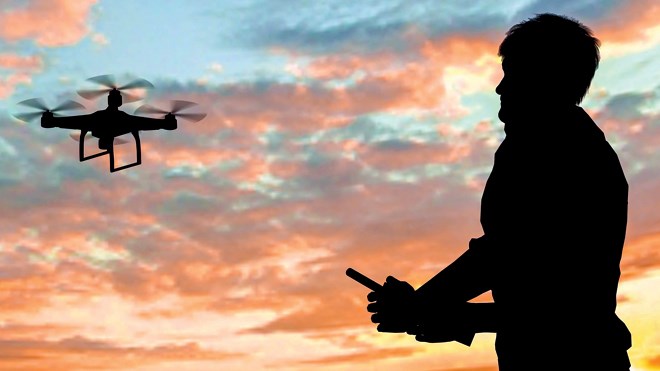Drones are revolutionizing the way scientists observe, measure and monitor the natural environment. From mapping the patterns of wildfires, like those in California, to measuring the size of jellyfish populations, drones have the potential to improve our understanding of the natural environment.
Although we use different names to refer to drones — for example, remotely piloted aircraft systems or unmanned aerial systems/vehicles — there is strong consensus among the scientific community about their potential to improve our understanding of the natural world.
Technological advancements and commercial investments into the drone market has been phenomenal over the past 10 years, with estimates that the annual global market could reach over US$40 billion by 2024. The growth of the commercial drone industry means that investment is helping them to become smaller, faster, smarter, safer and easier to fly.
The Integrated Remote Sensing Studio (IRSS) at the University of British Columbia’s Faculty of Forestry is at the forefront of researching novel applications of drones. The IRSS is demonstrating that its data can be much more than just pretty pictures. Work to date has included characterizing forest regeneration, improving forest inventory methods, mapping fire patterns, estimating jellyfish populations and mapping native plant species.
Ecological research applications
After learning how to operate a drone safely, users can acquire a variety of scientific data. For example, drones flying above a forest canopy can capture extremely detailed imagery and video that help in studying vegetation, identifying and counting wildlife and improving ecological understanding.
The potential to quickly and easily deploy drones in otherwise hard-to-access environments allows researchers to collect information that has previously been too expensive to gather.
The ability for drones to capture data without physically entering areas of interest limits the cost of field campaigns and reduces human impact on (sometimes fragile) ecosystems. This is important, especially when studying rare species of flora and fauna, like those in Arctic environments.
With ongoing concerns about the impacts of climate change, drone data captures a high-resolution snapshot of the state of environments at a specific moment in time. Given that some drones are inexpensive and easily deployed, repeated flights over the same area over time can help illuminate changes that would otherwise go unnoticed.
Seeing how environments are changing over time is important for understanding the impacts of climate change. For example, drones can help quantify changes in vegetation composition, whether growth is consistent or if natural disturbances like fire or insect attacks are becoming more prevalent.
Data types
Imagery and high-definition video using cameras, like those in a smart phone, are commonly used. The development of digital photogrammetric techniques that convert imagery into 3D data helps describe the physical structure of vegetation.
High-tech sensor options — such as near-infrared or thermal — capture what we can’t see with the naked eye, and are becoming more common. Laser sensors that shoot pulses of light help researchers create 3D representations of vegetated areas to inform management decisions. These lasers, commonly referred to as light detection and ranging (LIDAR), are also found on some self-driving cars.
The wide array of sensors that can be mounted on drones means that capturing this useful scientific data is already a reality. Information about forests — their distribution, appearance and health, along with details about their structure — produces cutting edge research and improves forest management practices.
A future with drones
Many aspects of drone technology make them increasingly desirable for scientific research. Earlier this year, we published a commentary in the journal Nature that argued that standardization of regulations, improvements in flight control and further battery and software technology developments will help to improve data quality and make drones more effective.
Continued investment in drone technology is spurring rapid development in lithium-ion battery efficiency and capacity; lightweight hardware materials like carbon fibre, and reductions in component size. These hardware advancements impact the amount of time drones can stay in the sky to capture more data, which means less downtime, more data and increasingly meaningful analyses.
Legislation and regulation
While the rapid advancement of drone technology is great news, it can be difficult to develop laws and regulations at the same pace.
The safety and privacy of the general public must always be the top priority. It has therefore been important for legislators, technological developers and end-users to collaborate on how technology is used and how regulations can uphold safety and privacy, while continuing to promote use.
Lines of sight
An example of current regulatory development is the ability for select users, such as environmental researchers, to apply to operate drones beyond the operator’s line of sight (BLOS).
Most federal and jurisdictional governments across the world require that operators always have visual contact with their drone. In some situations, like flying a drone over a forest, it can be very difficult for the operator to keep the drone in sight. Operators can apply for a BLOS permit, indicating how they will operate their drone according to specific safety protocols. These types of permits significantly improve how drones can be used in difficult-to-access areas. It also highlights how tasks like forest surveying or animal census projects can be made more cost-efficient and accurate using a drone.
There is no doubt that drones will be sticking around for the foreseeable future, and that novel applications for their use will continue to pop up. The benefits they have had, and continue to offer, in ecological research in such a short period is promising, helping researchers to better understand their environments with extremely high quality data. Ongoing imagery acquisitions will no doubt help in uncovering important findings and help to develop evidence-based policy.
Tristan R.H. Goodbody, Post-Doctoral Fellow, Forestry, University of British Columbia and Nicholas Coops, Professor and Canada Research Chair, University of British Columbia
This article is republished from The Conversation under a Creative Commons license. Read the original article.
